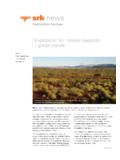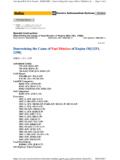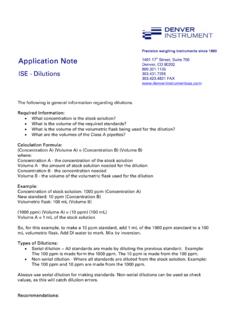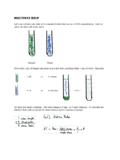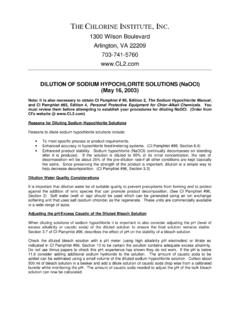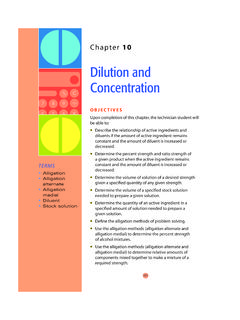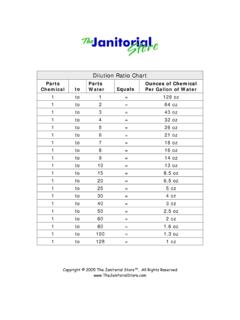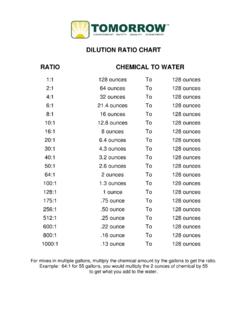Transcription of THE IMPORTANCE OF DILUTION FACTOR FOR OPEN PIT …
1 THE IMPORTANCE OF DILUTION FACTOR FOR OPEN PIT MINING PROJECTS* Anoush Ebrahimi, P. Eng., Principal Consultant at SRK Consulting 22nd Floor, 1066 West Hastings Street, Vancouver, BC, V6E 3X2, Canada (Corresponding author: * This article is the modified version of the paper that has been submitted to World Mining Congress, Montreal 2013 under the name of AN ATTEMPT TO STANDARDIZE THE ESTIMATION OF DILUTION FACTOR FOR OPEN PIT MINING PROJECTS . ABSTRACT Mining DILUTION is one of the most important factors affecting the economy of mining projects. While we do our best to identify and calculate all the other cost items of a project, no matter how small, it is common to make general assumptions about DILUTION instead of quantifying it. This is usually due to insufficient budget, time for studies and also lack of a well-defined methodology that can be used. Instead of quantifying DILUTION in mining studies it is common to assume a general DILUTION such as 5% for massive deposits and 10% for tabular shape deposits.)
2 While these figures may be a good starting point in early stages of mining studies, it does not take in to consideration the complexity of the problem. DILUTION FACTOR varies within a single mine for different benches and zones. This is due to changes we see in grade distribution and shape of ore body. It also varies based on commodity price. It is necessary to make sure that these variations are taken into account when designing or evaluating a mine. DILUTION increases the operating costs in the mill by increasing the tonnage of material to be milled. In addition to its direct impact on short term income of a mine, DILUTION causes significant changes in other factors that on the long term reduce the overall value of the project. For example, it prolongs the mine life by reducing mill s effective capacity. It also reduces the feed grade. In most cases, lower feed grade means lower mill recovery. DILUTION also increases the cut-off grade which in turn reduces the overall ore utilization of a mine.
3 In some cases, to take advantage of economies of scale, mining operations tend to plan for higher mining rates. Moving to a larger scale of operation means less selectivity, hence more DILUTION . This is true for all kind of deposits. High level and uncontrolled DILUTION may ultimately defeat the purpose of increasing production rates. If not impossible in theory it is nevertheless extremely difficult and expensive to eliminate DILUTION in practice. Some amount of DILUTION is practically unavoidable in most mining operations (Scoble and Moss, 1994). Although completely avoiding DILUTION may be impossible, we can measure and control it. By better understanding the root causes of the DILUTION and planning accordingly, it can be controlled and reduced. Ore losses and DILUTION are present at all stages of mining and while several models can investigate the influence of DILUTION it is its quantification that poses the most serious challenge (Pakalnis et al.)
4 , 1995). This paper introduces a methodology to quantify DILUTION FACTOR in open pit mines. The proposed approach makes use of general mining software available in most mining companies. Therefore it is amenable to most mining operations and provides a readily available tool for understanding mining DILUTION for operators and consultants. To illustrate the methodology the author uses an example from a hypothetical mine. DILUTION varies in different mines based on the deposit characteristics, operational aspects and economic cut-off grade. For instance, shape of the deposit, bench height, equipment size, and market conditions will have an impact on the level of DILUTION in a mine. It is paramount for mining projects to have a better understanding of DILUTION right from the beginning. In times like today, where mining operations must operate at peak efficiency, it is even more crucial to be able to calculate and have a better grasp of all the parameters influencing the economics of a project including DILUTION .
5 In order to produce better project evaluations, DILUTION studies should be an integral part of any project. KEYWORDS Open Pit, DILUTION , Selectivity, Mining studies, Mine design, and Mine evaluation INTRODUCTION Uncertainty and risk are inherent characteristics of mining projects. This is due to uncertainty in market conditions, resource models, and mining factors such as tonnages, grades and DILUTION . To reduce the risk of investment, mining companies dedicate a large amount of time and money during studies to estimate grades and tonnages as well as measuring the mining conditions and costs. Due to difficulties in measuring some of the important design parameters such as DILUTION , still there are factors that can be overlooked. With a holistic approach to design a mine that includes quantifying DILUTION in early stages of work, a good mining study will reduce the risk of investment and operation. Financial models calculate revenues by using tonnage and grade of ore which is determined during mine design.
6 Tonnage and grade are calculated using a resource model, DILUTION , and mine recovery factors . Reconciliation between what is actually mined and what was designed has been a concern of mining companies for a long time. The inherent uncertainty in resource modelling, no matter how dense the sampling program, is one of the main sources of discrepancies. Another source of discrepancies is the DILUTION FACTOR which is applied in reserve calculation. Estimating a reliable DILUTION FACTOR can reduce the discrepancy between design and operation and consequently can lower the overall risk of mining projects. Underestimating DILUTION may pose a significant risk to a project. For example a ten percent error in copper grade may result in a 60% change in the net present value (NPV) of a project (Parker 2012).Inaccurate DILUTION is a source of error for grade and tonnage sent to the mill. DEFINITION DILUTION refers to the waste material that is not separated from the ore during the operation and is mined with ore.
7 This waste material is mixed with ore and sent to the processing plant ( Jara 2006, A. Sinclair 2002). DILUTION increases tonnage of ore while decreasing its grade. DILUTION can be defined as the ratio of the tonnage of waste mined and sent to the mill to the total tonnage of ore and waste combined that are milled. It usually expressed in percent format. This can be expressed as: ( ) (1) For example if 10 tonnes of waste rocks (and/or below cut-off grade mineralized rocks) are mined with 90 tonnes of ore and all (100 tonne) being sent to mill, DILUTION is calculated to be According to this definition X percent of DILUTION in a mine suggests that X percent of the feed is not economically profitable to be processed. This X amount should not be sent to the crusher and proper actions must be taken in the mine to separate them from the feed as much as possible. Referring to a mining block, DILUTION happens in two different areas.
8 Sometimes within a mining block there are waste inclusions or low grade pockets of ore that cannot be separated and are inevitably mined with the mining block. This is called internal DILUTION . Internal DILUTION is difficult if not impossible to avoid. The amount of internal DILUTION varies in different types of deposits. Lithology and grade distribution are important factors in internal DILUTION . External DILUTION also called contact DILUTION refers to the waste outside of the orebody that is mined within the mining block. External DILUTION varies based on geology, shape of orebody, drilling and blasting techniques, scale of operation and equipment size. This is the type of DILUTION that can be controlled using proper equipment and mining practices. Figure 1 shows a mining block in a bench of an open pit mine with different types of dilutions. Figure 1A mining block in an open pit and different types of DILUTION MINE VALUE DIMINUTIONS DUE TO DILUTION 1.
9 One of the main consequences of DILUTION is the reduction of mill feed grade. Lower feed grade means less income. For marginal grade ore, DILUTION may reduce the grades to a degree that it becomes uneconomic to be processed, in other words DILUTION may turn an ore block to waste. The feed grade after DILUTION can be calculated using the equation (2). (2) Where: - is the Mill feed grade - is the grade of ore in ground - is the grade of waste rock - is the DILUTION (a value between 0 to 1) The same unit must be used for all grades in this equation. Table 1 shows the effect of 10% DILUTION on ore grade for a gold mine for one tonne of ore. Assaying showed that waste rocks have a small amount of gold. The gold grade in waste rocks is gram per tonnes. The milling cut-off grade for this operation is calculated to be It means that a tonne of ore with can be sent to the mill and be expected to generate a small amount of profit.
10 Ten percent DILUTION in this mine will reduce the grade of ore from to which is below cut-off grade and will not be able to return a profit. This block will be considered as waste after 10% DILUTION . Table 1 Effect of DILUTION on Ore Grade in a Gold Mine Original Ore (g/t) DILUTION (%) Waste Au (g/t) Mill Feed (g/t) 10% 10% 10% 10% Based on the discussion above, it can be expected that due to higher milling cut-off grade, caused by DILUTION , the overall reserve of the mine will decrease within a given pit. 2. Due to DILUTION , energy and materials that are used in the processing plant to treat the waste portion of the feed are wasted. As a result, the mill unit operating cost increases directly by the amount of the DILUTION FACTOR . For example in a project whose processing cost has been estimated at $18/t,a 10% DILUTION means $ spent processing waste in the mill for every tonne of feed. For a 30,000 tonne a day operation this amount of DILUTION means $54,000 is wasted every day.
